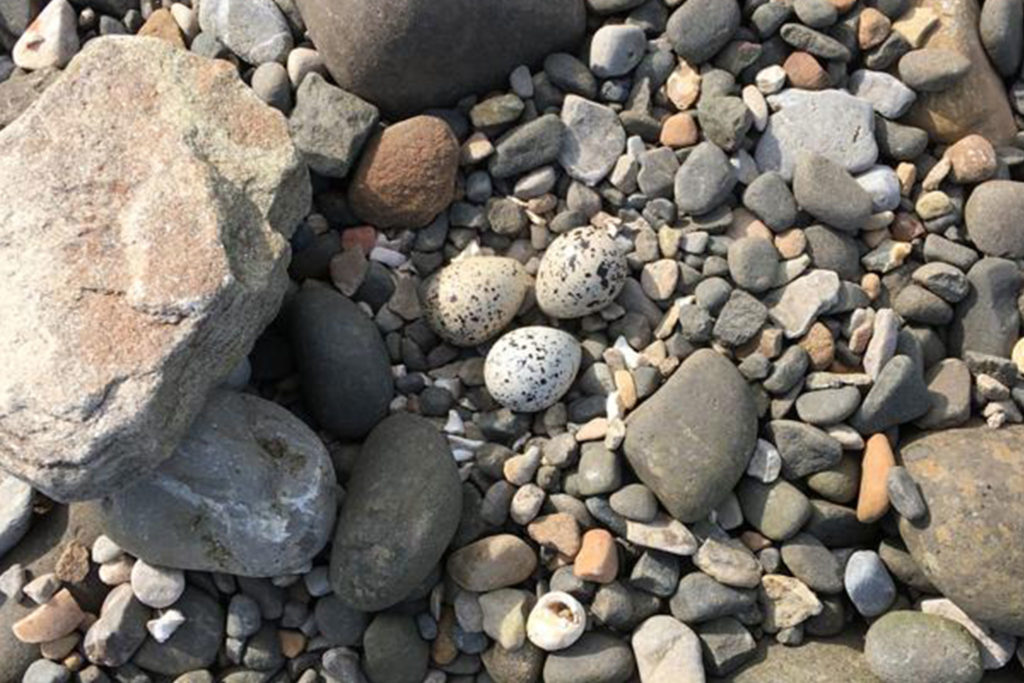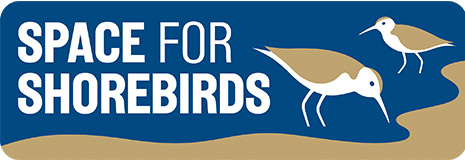A soaking and stormy winter hasn’t put off our nesting shorebirds!
It has been an amazingly wet start to spring, with rainfall records being broken across the country and lots of challenges for both people and wildlife. But while we can retreat indoors when the springtime weather really turns, much of our wildlife must keep going with the busy task of raising the next generation.
At the time of writing this blog, we have pairs of our beach nesting shorebirds setting up territories all along the coast. They are battling it out with other breeding pairs for access to the best nesting locations where their eggs will be safe, and their chicks will find rich food to help them grow fast. We are also excited to have found that some pairs have already laid their first clutch of eggs. The parent birds will now spend the next 25 days attentively watching over them till they hatch, taking turns to either keep the eggs warm by sitting on them or standing guard nearby and watching for potential dangers. This year, our first clutch was over two weeks earlier than previous years and is likely a reflection of the unseasonably mild weather we had earlier in the year. However, after this initial flurry of activity the recent cold spell has seemed to put the brakes on some of the other pairs.

Many of you who have visited the coast over recent months will have noticed that there has been large amounts of erosion this winter all along Northumberland’s beaches. Noticeably, many of the sand dune faces have been weathered back to steep cliffs and much of the marram grass has been ripped up and deposited in big straw-like drifts. We have also lost a great volume of the sand that usually makes up the gentle slope of the beach. It has been scoured out by the powerful crashing waves of the remarkable number of storms we have experienced this winter.
Unfortunately, this loss of height in the slope of the beach could be a worrying development for the birds looking to build their nests. Both ringed plovers and oystercatchers need to nest out in the open on bare patches of sand or shingle, where they make a small bowl-shaped scrape in which to lay their eggs. They do this because their eggs are fantastically camouflaged and look identical to small pebbles, keeping them safe and hidden from hungry predators. As such, these birds rely on open patches of beach that are high enough that they stay above the waves even on the highest tides, otherwise their eggs would be washed away. The loss of sand height this year means that many of these suitable sites have been lost and are now completely submerged by the tide, meaning the birds are under more pressure than usual to claim a safe nesting location.
So, what does this mean in practice for our nest protection efforts this breeding season?

Many of you will be familiar now with the protection areas we have put up over the past few years at various sites along the coast where we have had ringed plover and oystercatcher breeding. The combination of rope and net fencing along with signage has been working well and has helped birds fledge chicks in areas where they had been really suffering from disturbance previously. Unfortunately, because of the erosion to the suitable habitat, many of our previous sites that we were expecting to protect again this year now don’t look as suitable as they once did. The breeding site at Buston links, just to the south of the Aln estuary, as well as the sites at Embleton burn and Newton beach have all changed dramatically, so we are waiting to see how these sites progress through the season before putting up any of our fencing and signs. We’ll be checking the sites regularly, but please do share with us any sightings of birds using those areas, particularly if you think they might be looking to nest!
One location that seems to have benefited from the rough wither seas is the beach at Lynemouth, south of the power station. The long ridge of rubble and rocks that has spanned the length of the beach in previous seasons has been smoothed out, and while lots of the sand has been lost much of the beach is still high enough for shorebirds to nest safely. The loss of sand has also left behind some fantastic areas of larger shingle which is of the perfect size to help provide excellent camouflage for shorebird eggs.
It is important to remember that beaches are naturally incredibly dynamic places, and the species that live there can only do so because they have evolved to survive in rapidly changing habitats. Sediments are constantly on the move, building up in one area and washing away in another, and without this change we wouldn’t get the exposed areas of sand and shingle that our shorebirds rely on as they would quickly become covered in marram grass and other plants. Also, the sand that seems to have been lost hasn’t disappeared completely and has likely been dumped offshore by the winter storms. Over the summer, the action of the tides and gentler waves will bring this sediment back in to our beaches and their height will build up once again. So, sites that may look disappointing now may become much more suitable later in the breeding season, allowing birds to move in that have failed nesting elsewhere and are looking to have another shot.
The reality of our changing climate means that from now on, we are likely to have much more unpredictable weather, including more storms and wetter winters. This means that challenging starts to the breeding season, like the one we are working with this year, are likely to become much more common. Therefore, it is more important than ever to give our vulnerable shorebirds that best helping hand we can and be as adaptable in our approach as possible.

Another new development for this year’s breeding season is that we are trialing the use of our new nest cage design for vulnerable ringed plovers. Bird eggs are packed full of nutrients and calories and therefore make a very attractive meal for a whole range of predator species, and because ringed plovers nest on the ground the eggs are also exposed to animals like foxes, hedgehogs and stoat. A certain level of predation is completely natural and is to be expected on any breeding bird site. However, last season a number of our breeding locations were absolutely hammered by crows taking eggs and chicks, to the point that some really good areas of habitat didn’t have a single successful fledging.
To try and protect the plovers’ eggs this year we have designed a metal mesh dome that will sit over the nest, with a mesh size that allows the adult birds to pass through but is too small for larger predators, and crows in particular, to get at the eggs. These have been shown to dramatically increase the hatching success of ringed plovers, but must be used carefully and are only suitable in certain locations because they also make the nests much more obvious. Also, some predators can learn that “cages means eggs” so it is important that we put out enough decoy cages without a nest inside to stop them making this association. While these cages won’t be a fix-all solution, we are hoping that they will make a real difference to the hatching success this year and will be another tool for our efforts to protect our plovers.

How can you help protect these fantastic little birds?
We have just launched a new “nesting season” page on our website where you can find lots of information about the beach nesting birds of Northumberland, but in general our guidance for keeping them safe is to look out for our signs and fenced areas when on the beach and give them space so as not to disturb the birds. When walking past the nesting sites we also ask people to keep their dogs close by and to watch out for chicks that will regularly wander down the beach outside of the fences in search of food. We also have a fantastic group of volunteers who help us with all aspects of the nesting season, from finding plover territories to chickwatch sessions, and we are always looking for more members! If you would like some more details about becoming a volunteer please do get in touch by email (SpaceforShorebirds@northumberland.gov.uk) or on our social media.
Thanks for giving space to our shorebirds!


